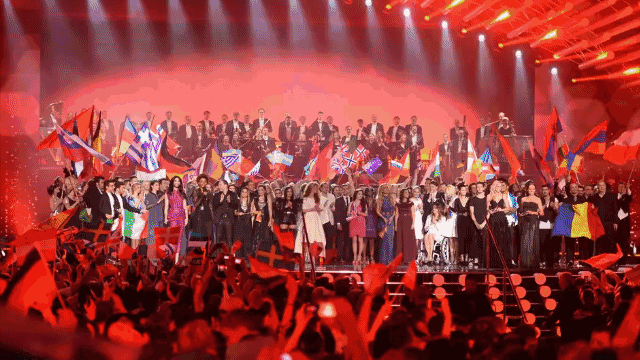
NEUROVISION
the neuroscience of eurovision
In our laboratory, we showed 8 songs from Eurovision 2022 to almost 100 people while they wore a physiological sensor. We then analysed their heart rate and electrodermal responses to each song, and used the results to make predictions about how those songs would place on the 14th May. You can read the small print below, and see how we reached these results by combining measures of narrative and emotional engagement, but first - here are our predictions!
To reach these predictions, we looked at two key measures of engagement - story and emotion. We’ll explain what each of these physiological signals told us, and then show you how we combined them to make our prediction.
We calculated the similarity between people’s electrodermal activity as they watched each song - calculating if they had the same small changes in their sweat production moment by moment. In our previous work we have found that this can measure how much people are engaged by the story of a video. Here are the rankings of the 8 songs. Perhaps surprisingly, Australia came first! Interestingly, this peak in EDA synchrony came at one of the most dramatic moments of Australia’s performance. It seems to have resonated with our participants.
Secondly, we calculated how similar peoples’ heart rates were. Previously, we found that when audiences were emotionally engaged in a performance, their heart rates synchronised over time, and they felt more emotionally connected to each other. Here, Sweden came first. While listening to this song, our participants’ hearts were more likely to be synchronised with each other, suggesting that they felt more emotionally engaged with the performance
The question is: what’s more important for a Eurovision song, story or emotion? We don’t yet know, but we are really interested in the underlying scientific issues. So after the results come in, we will be doing a lot more analysis on our data. Our scientific goal is to find out how the psychological experience of an incredible performance is mirrored in the shared physiological state of the audience. But until we have the final results to explore, we have produced a simple, composite ranking to make our predictions!
Of course, many people are trying to predict the outcome of Eurovision 2022. We even asked our participants to rank how they thought the songs would finish. Here’s how our predictions, from implicit neurophysiological signals, compare to the explicit rankings rankings our participants made, how the bookies rank each song’s odds, and how a shadow jury and fan votes have predicted the results.
The small print
Our goal was to predict the general public’s vote for only these 8 songs. We are not predicting the jury vote, or the overall rankings. Remember, we only studied these 8 songs, and so we can only predict the order that they will place compare to each other. It could be that one of the songs that we did not study may be the overall winner, but we can only make predictions about these 8. Also, there are two rounds in the Eurovision Contest. First each country’s jury of experts allocate their points. Sometimes people think those votes can be influenced by bias and politics between countries. Second, people across Europe places their vote for their favourite song. We are trying to predict only the second element - how the general public will vote for these songs.
You can read more about the details of our experiment on our Open Science Foundation page. The page will be / has been date stamped and sealed on May 13th, the day before Eurovision, so that we cannot change our predictions!



